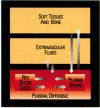Abstract
Although considerable progress has been made in recent years in reducing human exposures to lead, the potential for high intake of this contaminant still exists in millions of homes and in many occupational settings. Moreover, there is growing evidence that levels of lead intake considered inconsequential just a few years ago can result in subtle, adverse health effects, particularly in children. Consequently, there have been increased efforts by health protection agencies to develop credible, versatile methods for relating levels of lead in environmental media to levels in blood and tissues of exposed humans of all ages. In a parallel effort motivated largely by the Chernobyl nuclear accident, the International Commission on Radiological Protection (ICRP) is assembling a set of age-specific biokinetic models for calculating radiation doses from environmentally important radionuclides, including radioisotopes of lead. This paper describes a new age-specific biokinetic model for lead originally developed for the ICRP but expanded to include additional features that are useful for consideration of lead as a chemical toxin. The model is developed within a generic, physiologically motivated framework designed to address a class of calciumlike elements. This framework provides a useful setting in which to synthesize experimental, occupational, and environmental data on lead and exploit common physiological properties of lead and the alkaline earth elements. The modular design is intended to allow researchers to modify specific parameter values or model components to address special problems in lead toxicology or to incorporate new information. Transport of lead between compartments is assumed to follow linear, first-order kinetics provided the concentration in red blood cells remains below a nonlinear threshold level, but a nonlinear relation between plasma lead and red blood cell lead is modeled for concentrations above that level. The model is shown to be consistent with data on human subjects exposed to lead under a variety of experimental and natural conditions.
Full text
PDF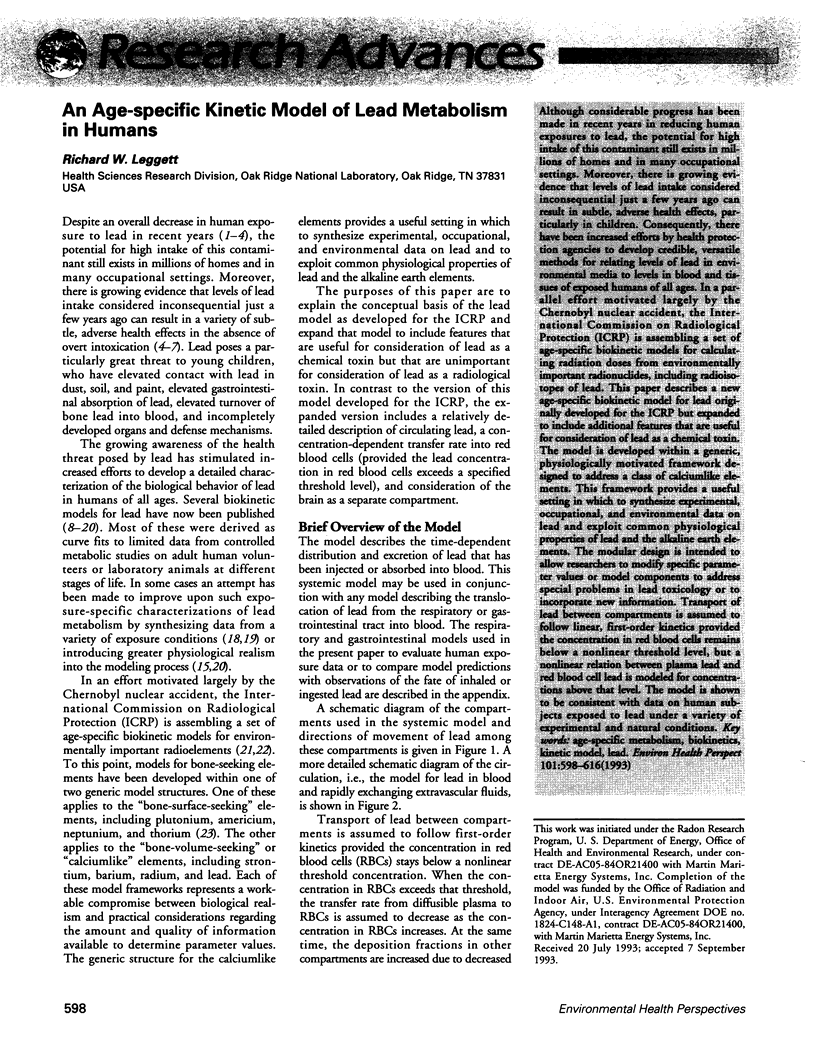
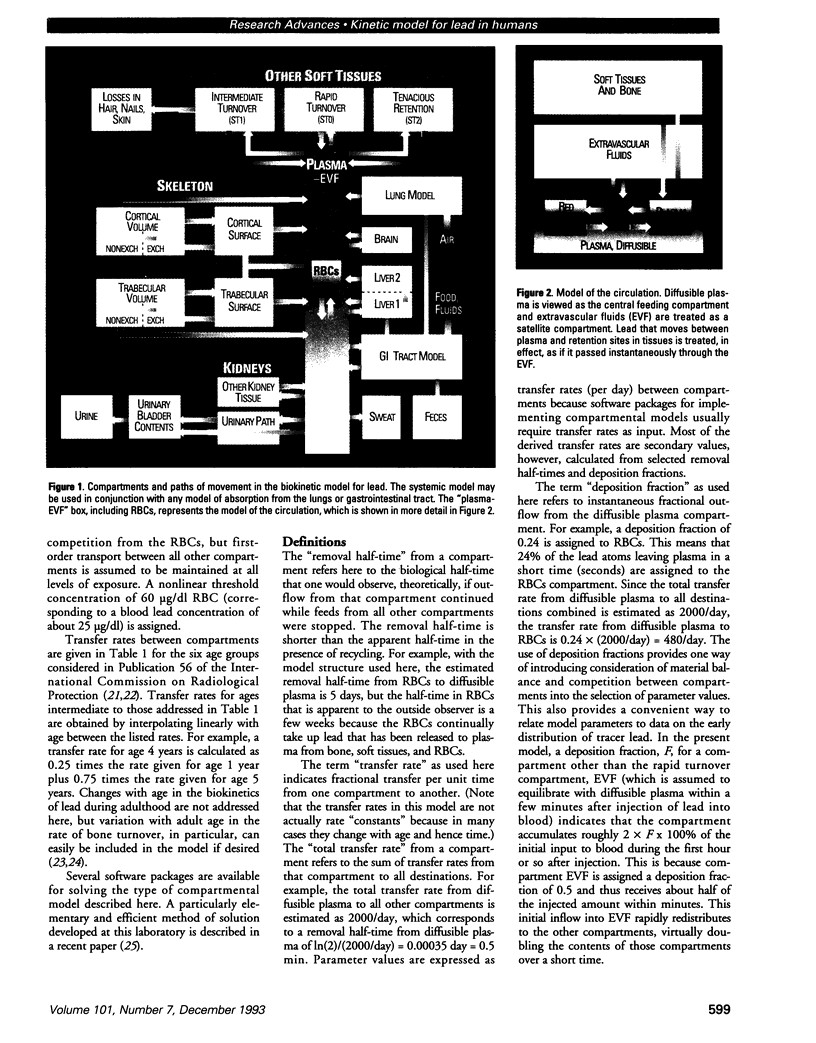
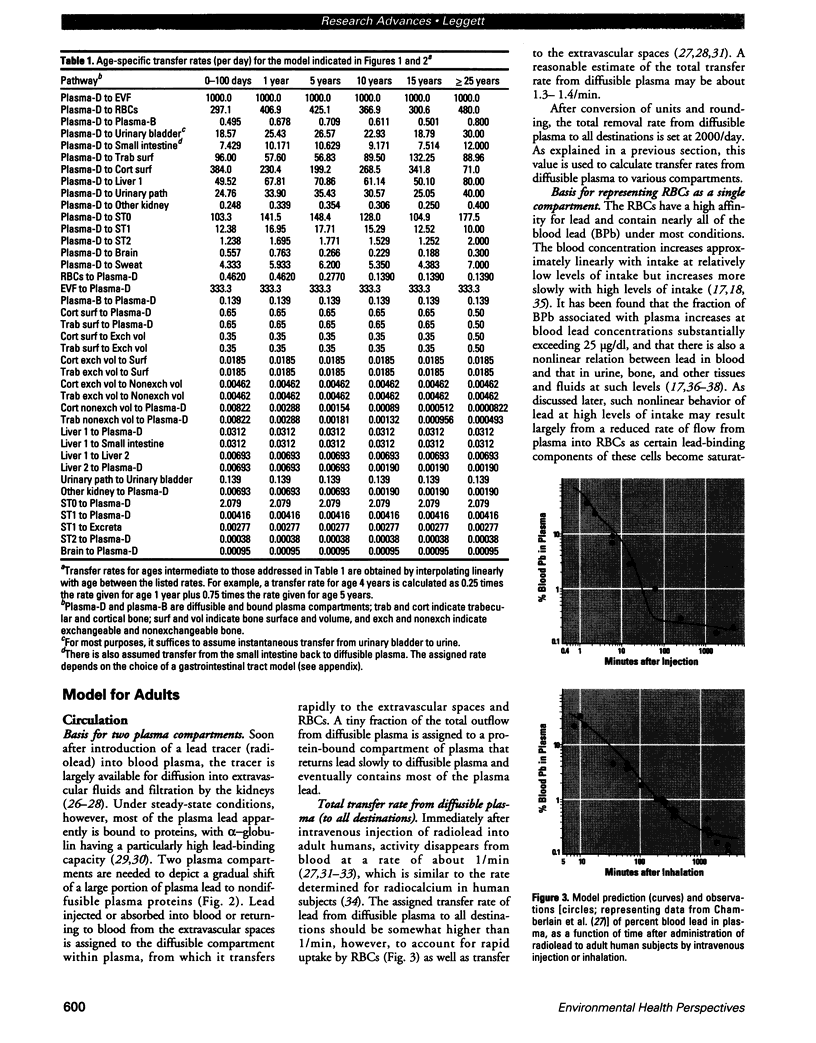
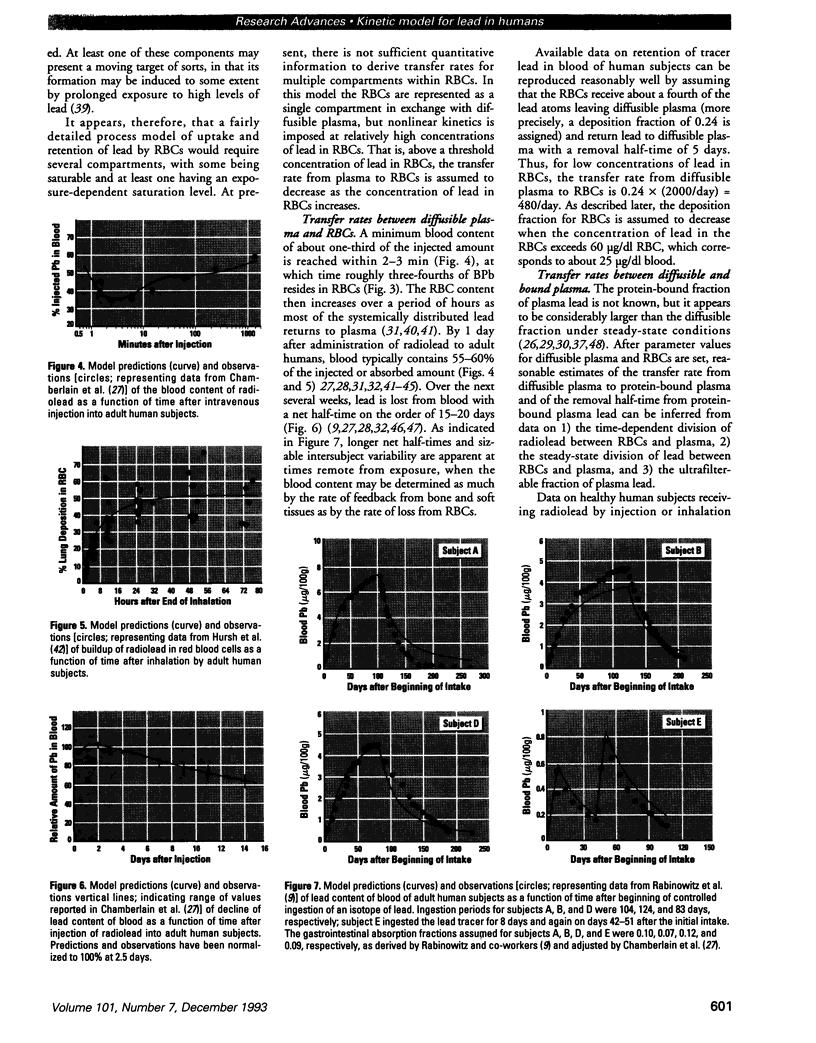
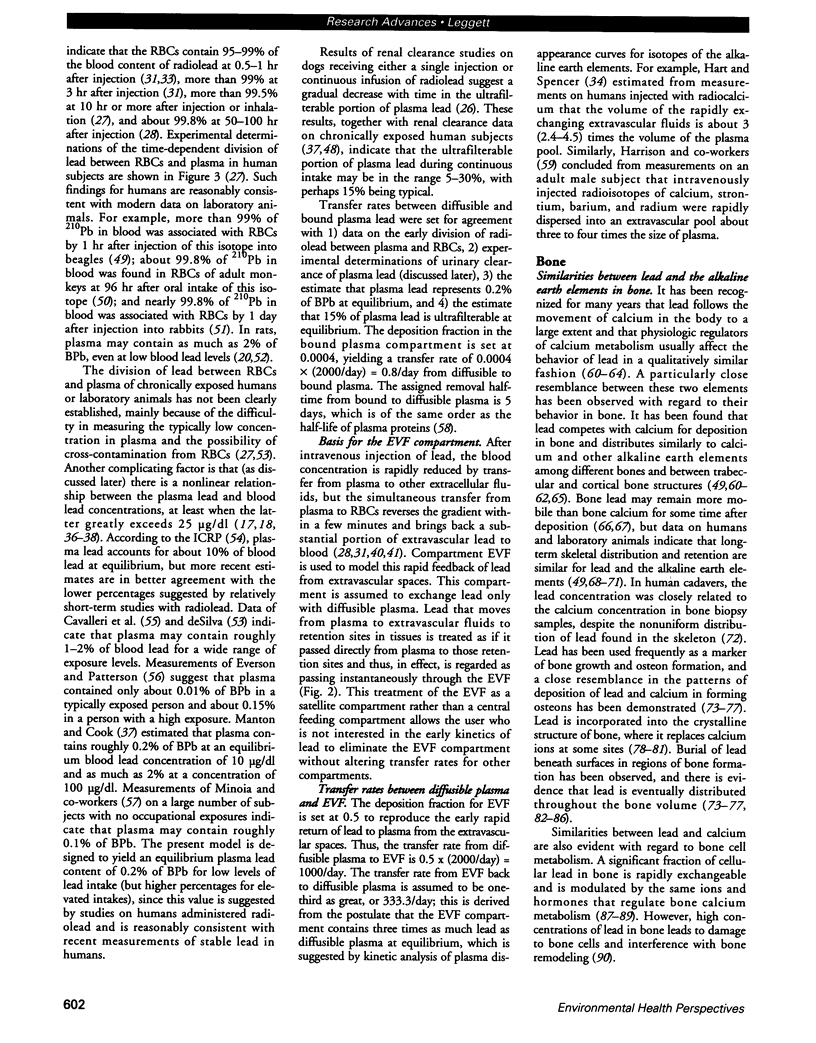

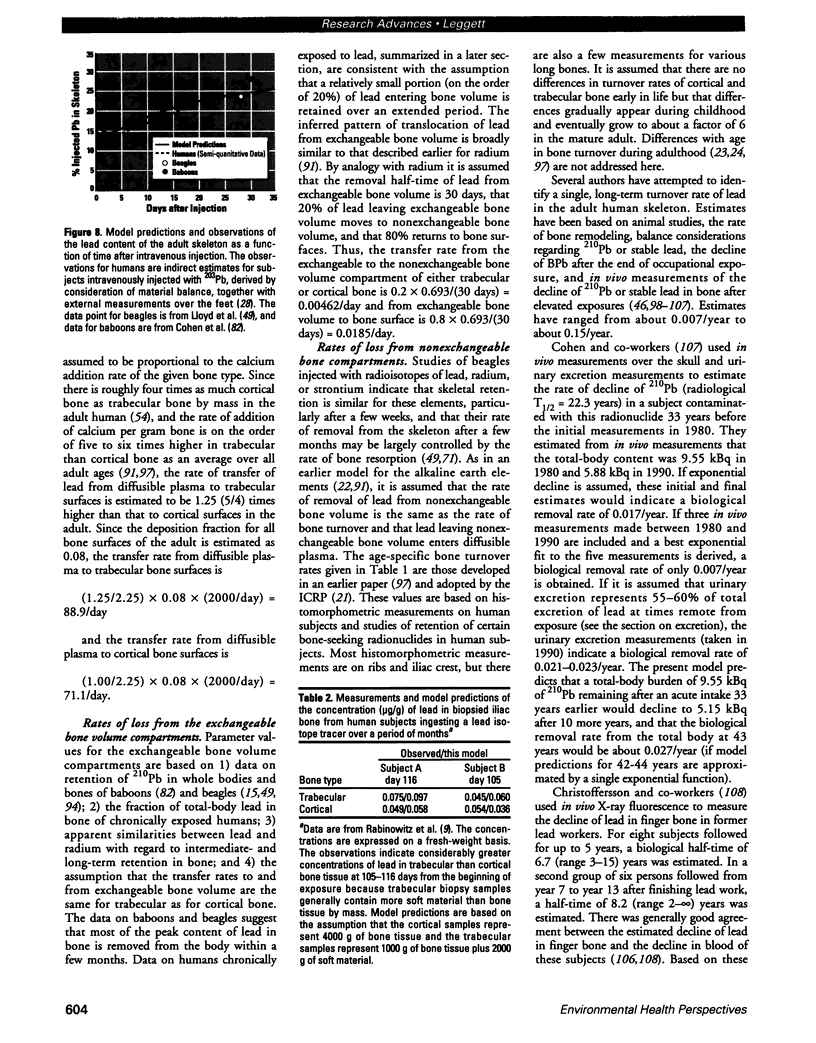
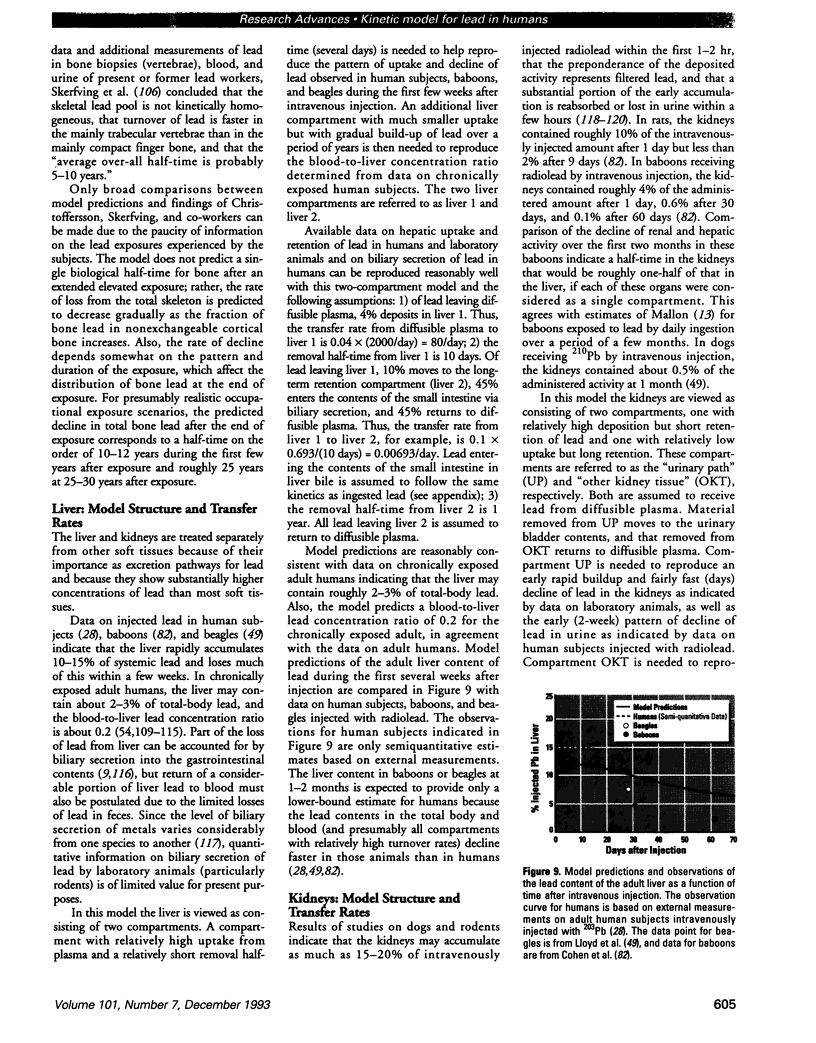
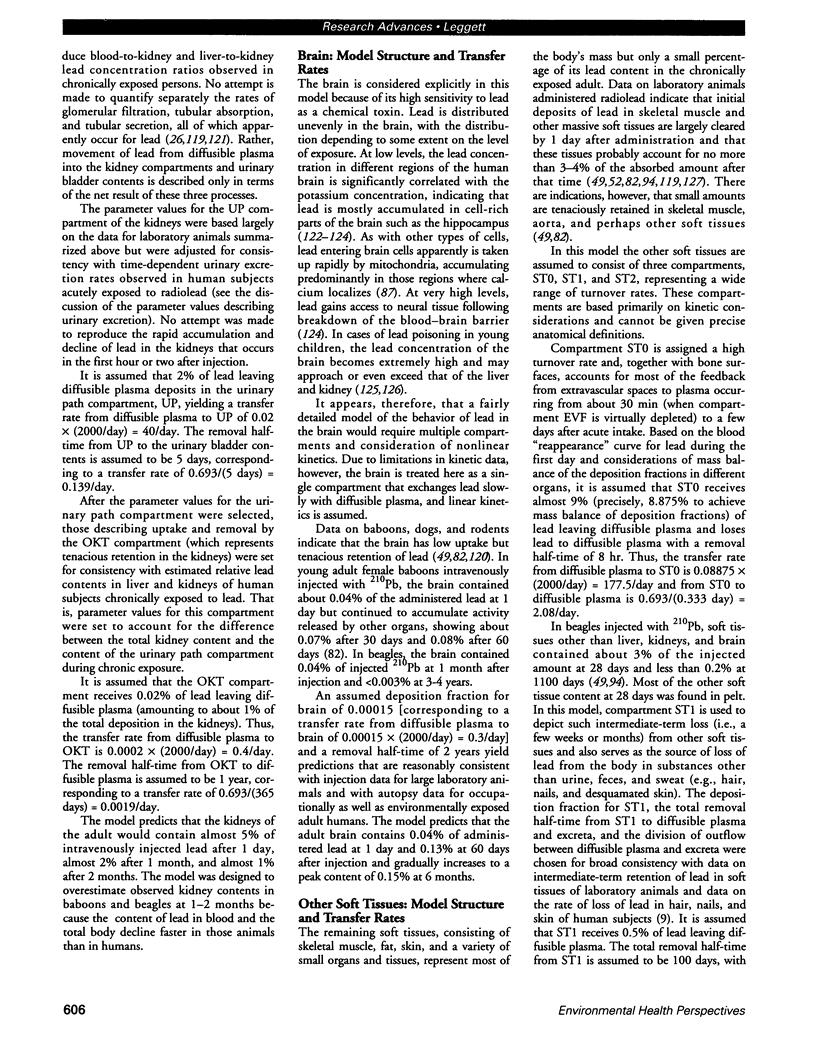
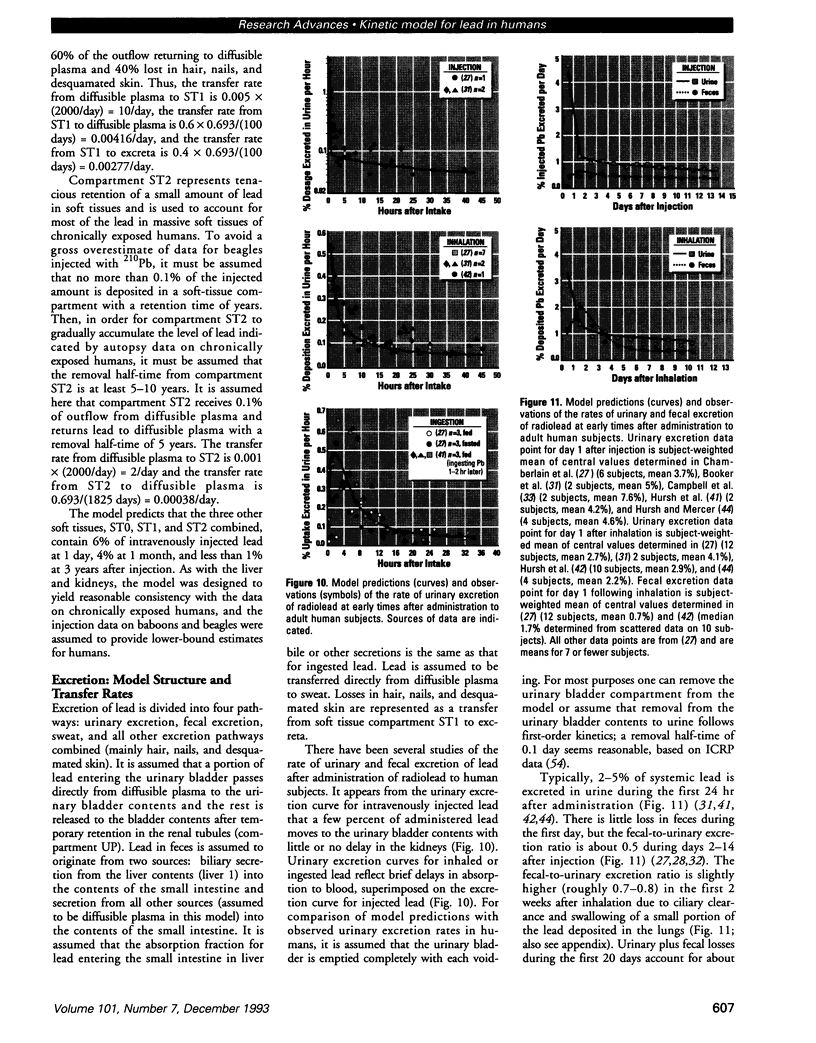
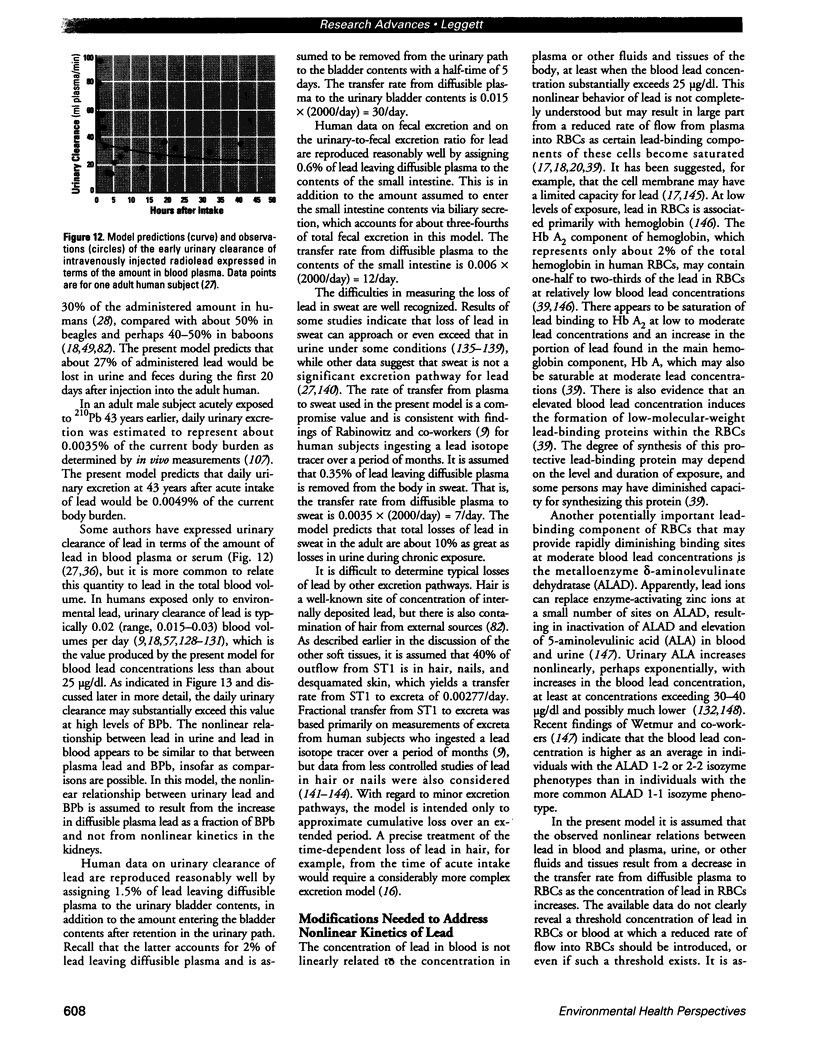
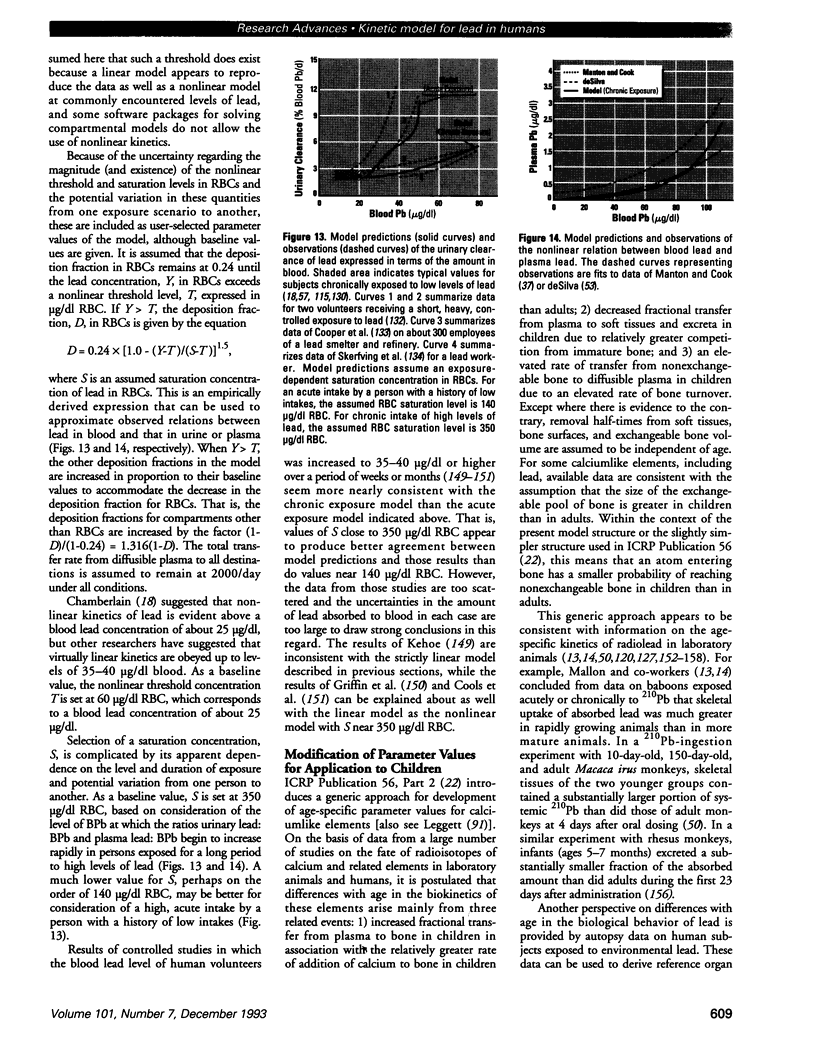
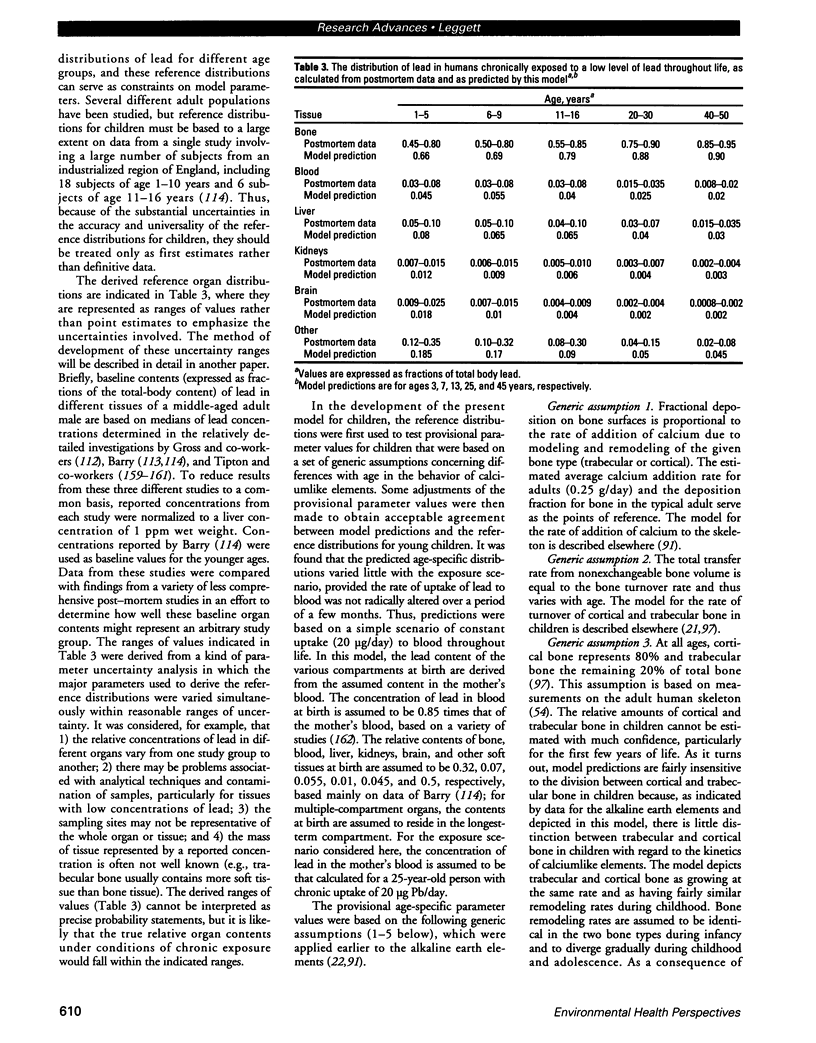
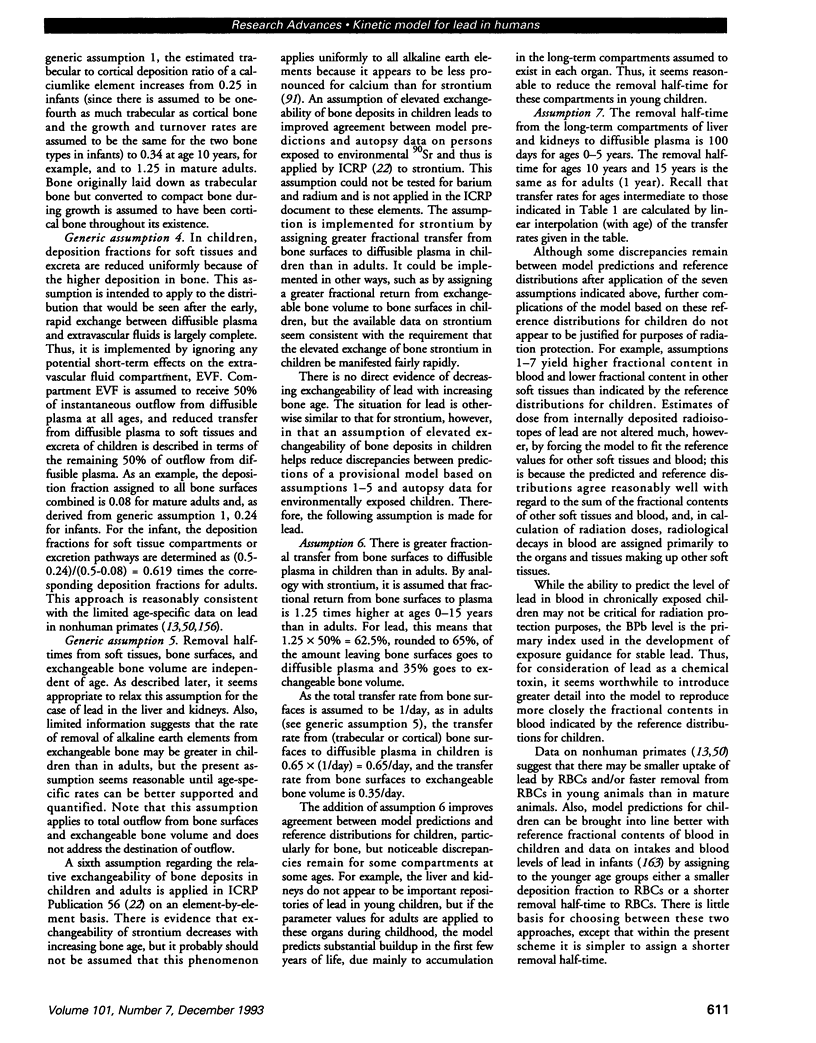
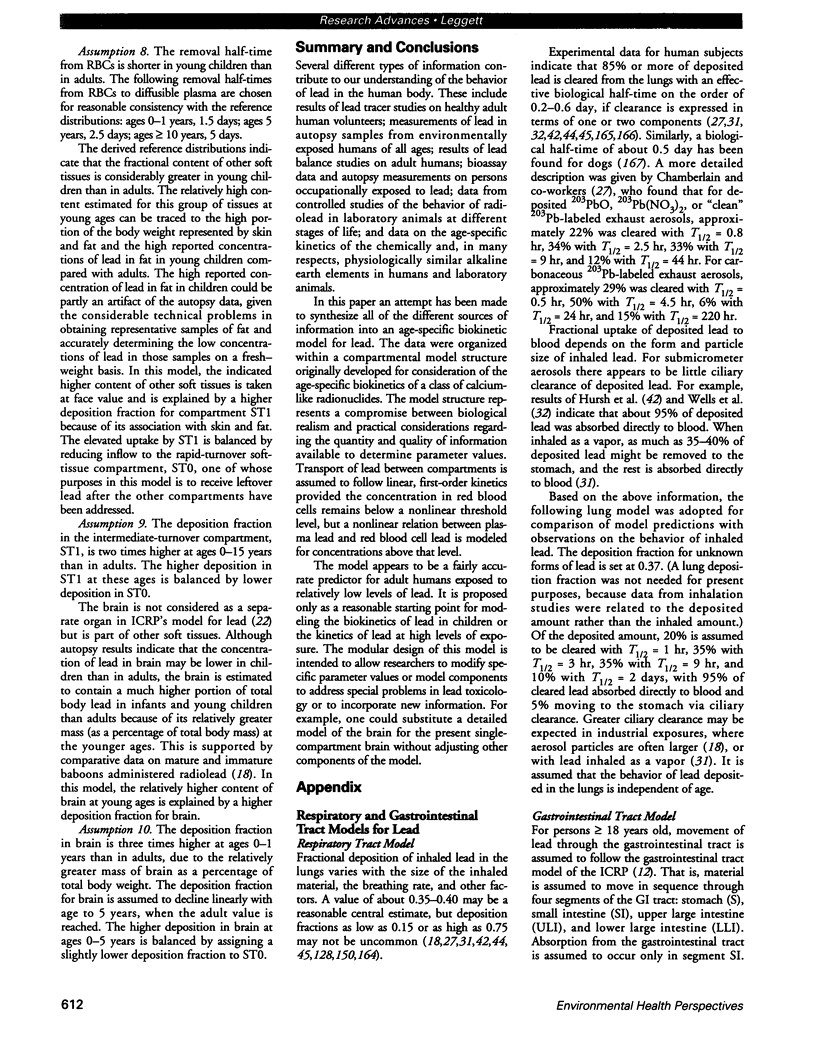
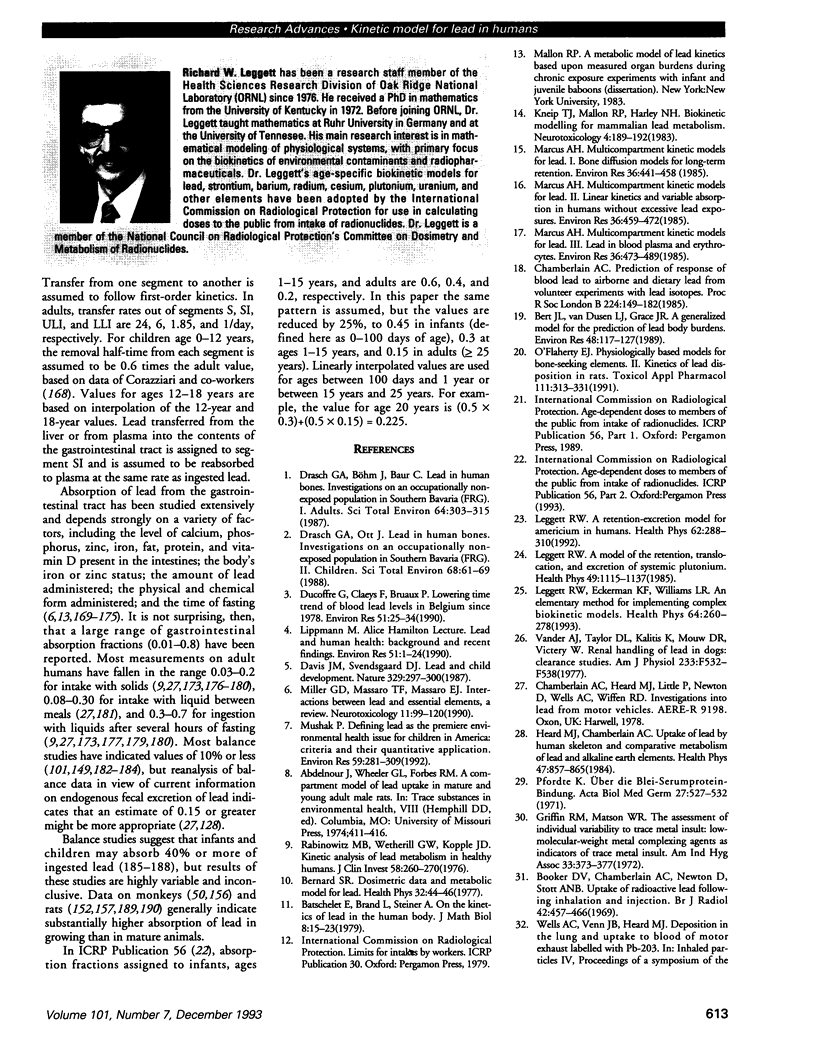
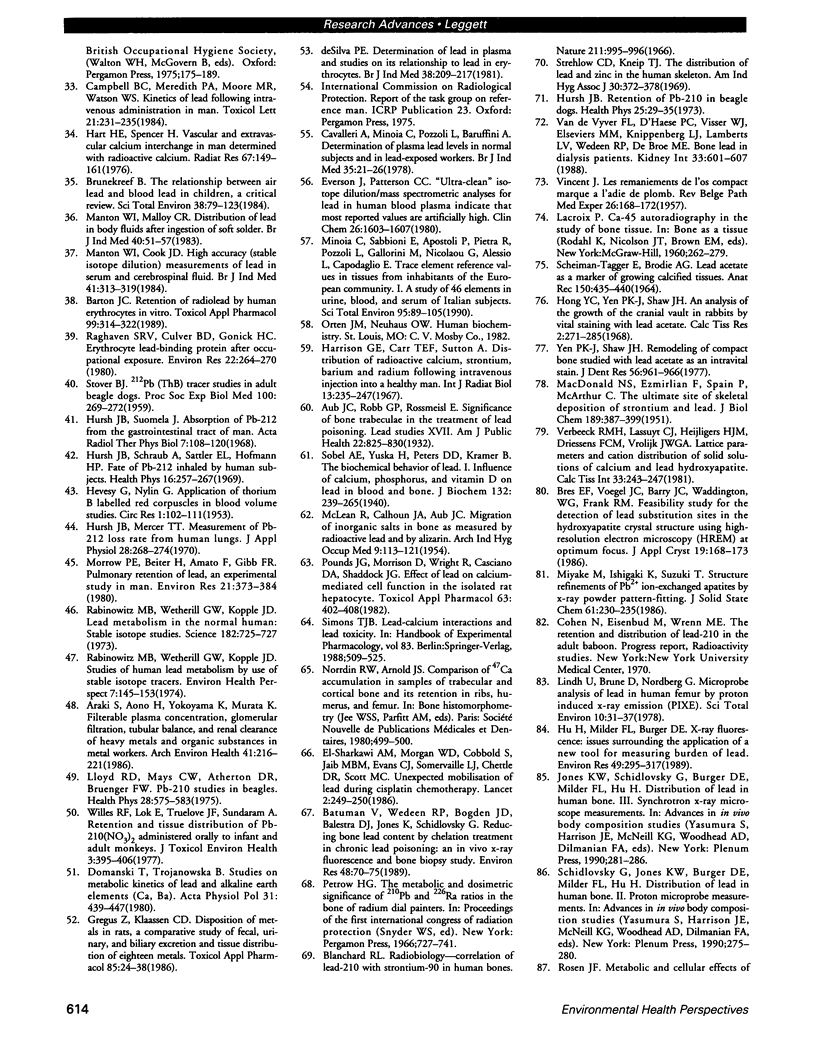
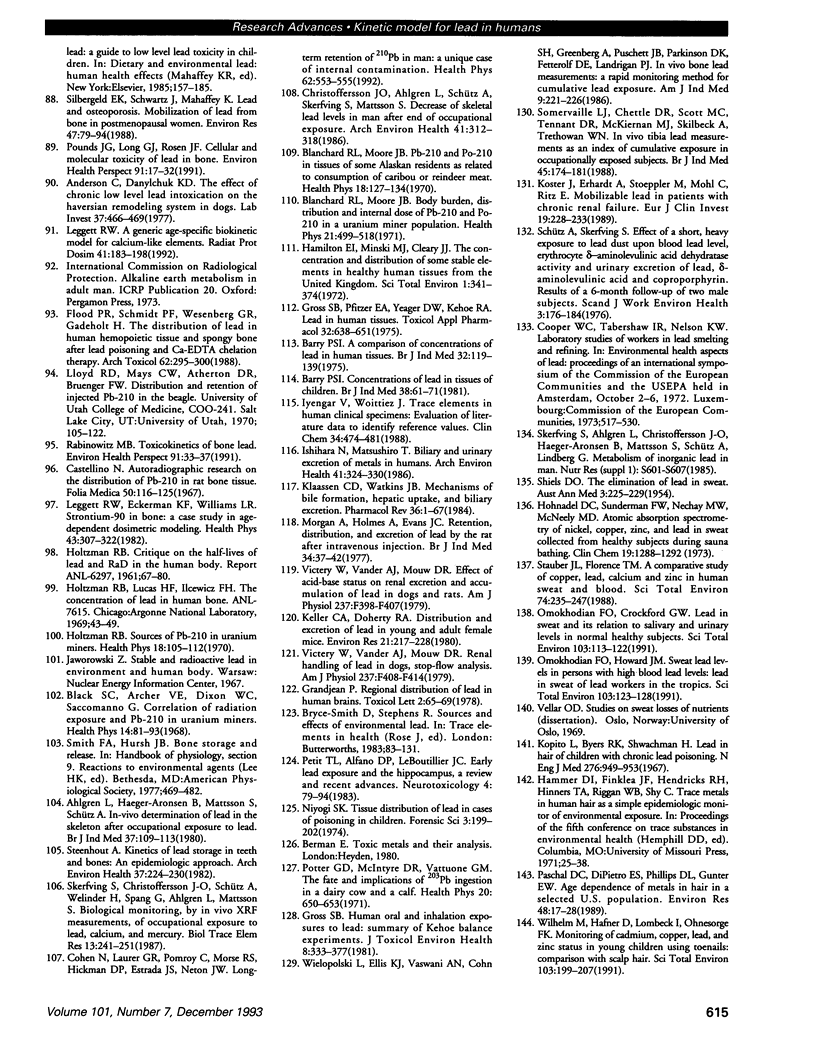
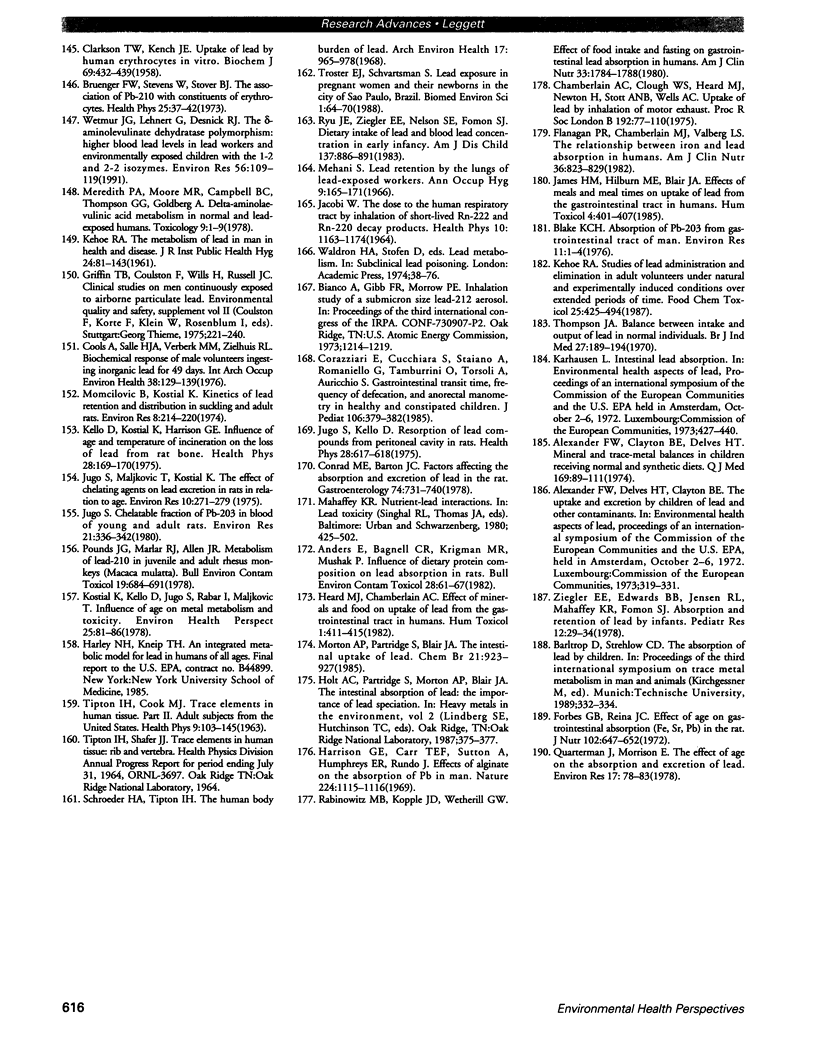
Images in this article
Selected References
These references are in PubMed. This may not be the complete list of references from this article.
- Ahlgren L., Haeger-Aronsen B., Mattsson S., Schütz A. In-vivo determination of lead in the skeleton after occupational exposure to lead. Br J Ind Med. 1980 May;37(2):109–113. doi: 10.1136/oem.37.2.109. [DOI] [PMC free article] [PubMed] [Google Scholar]
- Anders E., Bagnell C. R., Jr, Krigman M. R., Mushak P. Influence of dietary protein composition on lead absorption in rats. Bull Environ Contam Toxicol. 1982 Jan;28(1):61–67. doi: 10.1007/BF01608414. [DOI] [PubMed] [Google Scholar]
- Anderson C., Danylchuk K. D. The effect of chronic low level lead intoxication on the Haversian remodeling system in dogs. Lab Invest. 1977 Nov;37(5):466–469. [PubMed] [Google Scholar]
- Araki S., Aono H., Yokoyama K., Murata K. Filterable plasma concentration, glomerular filtration, tubular balance, and renal clearance of heavy metals and organic substances in metal workers. Arch Environ Health. 1986 Jul-Aug;41(4):216–221. doi: 10.1080/00039896.1986.9938336. [DOI] [PubMed] [Google Scholar]
- Aub J. C., Robb G. P., Rossmeisl E. Significance of Bone Trabeculae in the Treatment of Lead Poisoning : Lead Studies XVII. Am J Public Health Nations Health. 1932 Aug;22(8):825–830. doi: 10.2105/ajph.22.8.825. [DOI] [PMC free article] [PubMed] [Google Scholar]
- Barry P. S. A comparison of concentrations of lead in human tissues. Br J Ind Med. 1975 May;32(2):119–139. doi: 10.1136/oem.32.2.119. [DOI] [PMC free article] [PubMed] [Google Scholar]
- Barry P. S. Concentrations of lead in the tissues of children. Br J Ind Med. 1981 Feb;38(1):61–71. doi: 10.1136/oem.38.1.61. [DOI] [PMC free article] [PubMed] [Google Scholar]
- Barton J. C. Retention of radiolead by human erythrocytes in vitro. Toxicol Appl Pharmacol. 1989 Jun 15;99(2):314–322. doi: 10.1016/0041-008x(89)90013-6. [DOI] [PubMed] [Google Scholar]
- Batschelet E., Brand L., Steiner A. On the kinetics of lead in the human body. J Math Biol. 1979 Jul 13;8(1):15–23. doi: 10.1007/BF00280582. [DOI] [PubMed] [Google Scholar]
- Batuman V., Wedeen R. P., Bogden J. D., Balestra D. J., Jones K., Schidlovsky G. Reducing bone lead content by chelation treatment in chronic lead poisoning: an in vivo X-ray fluorescence and bone biopsy study. Environ Res. 1989 Feb;48(1):70–75. doi: 10.1016/s0013-9351(89)80086-6. [DOI] [PubMed] [Google Scholar]
- Bernard S. R. Dosimetric data and metabolic model for lead. Health Phys. 1977 Jan;32(1):44–46. [PubMed] [Google Scholar]
- Bert J. L., van Dusen L. J., Grace J. R. A generalized model for the prediction of lead body burdens. Environ Res. 1989 Feb;48(1):117–127. doi: 10.1016/s0013-9351(89)80090-8. [DOI] [PubMed] [Google Scholar]
- Black S. C., Archer V. E., Dixon W. C., Saccomanno G. Correlation of radiation exposure and lead-210 in uranium miners. Health Phys. 1968 Feb;14(2):81–93. doi: 10.1097/00004032-196802000-00001. [DOI] [PubMed] [Google Scholar]
- Blanchard R. L. Correlation of lead-210 with strontium-90 in human bones. Nature. 1966 Aug 27;211(5052):995–996. doi: 10.1038/211995a0. [DOI] [PubMed] [Google Scholar]
- Blanchard R. L., Moore J. B. 210Pb and 210Po in tissues of some Alaskan residents as related to consumption of caribou or reindeer meat. Health Phys. 1970 Feb;18(2):127–134. doi: 10.1097/00004032-197002000-00004. [DOI] [PubMed] [Google Scholar]
- Blanchard R. L., Moore J. B. Body burden, distribution and internal dose of 210Pb and 210Po in a uranium miner population. Health Phys. 1971 Oct;21(4):499–518. doi: 10.1097/00004032-197110000-00001. [DOI] [PubMed] [Google Scholar]
- Booker D. V., Chamberlain A. C., Newton D., Stott A. N. Uptae of radioactive lead following inhalation and injection. Br J Radiol. 1969 Jun;42(498):457–466. doi: 10.1259/0007-1285-42-498-457. [DOI] [PubMed] [Google Scholar]
- Brunekreef B. The relationship between air lead and blood lead in children: a critical review. Sci Total Environ. 1984 Sep;38:79–123. doi: 10.1016/0048-9697(84)90210-9. [DOI] [PubMed] [Google Scholar]
- CLARKSON T. W., KENCH J. E. Uptake of lead by human erythrocytes in vitro. Biochem J. 1958 Jul;69(3):432–439. doi: 10.1042/bj0690432. [DOI] [PMC free article] [PubMed] [Google Scholar]
- Campbell B. C., Meredith P. A., Moore M. R., Watson W. S. Kinetics of lead following intravenous administration in man. Toxicol Lett. 1984 May;21(2):231–235. doi: 10.1016/0378-4274(84)90212-1. [DOI] [PubMed] [Google Scholar]
- Cavalleri A., Minoia C., Pozzoli L., Baruffini A. Determination of plasma lead levels in normal subjects and in lead-exposed workers. Br J Ind Med. 1978 Feb;35(1):21–26. doi: 10.1136/oem.35.1.21. [DOI] [PMC free article] [PubMed] [Google Scholar]
- Chamberlain A. C., Clough W. S., Heard M. J., Newton D., Stott A. N., Wells A. C. Uptake of lead by inhalation of motor exhaust. Proc R Soc Lond B Biol Sci. 1975 Dec 31;192(1106):77–110. doi: 10.1098/rspb.1975.0152. [DOI] [PubMed] [Google Scholar]
- Chamberlain A. C. Prediction of response of blood lead to airborne and dietary lead from volunteer experiments with lead isotopes. Proc R Soc Lond B Biol Sci. 1985 Apr 22;224(1235):149–182. doi: 10.1098/rspb.1985.0027. [DOI] [PubMed] [Google Scholar]
- Christoffersson J. O., Ahlgren L., Schütz A., Skerfving S., Mattsson S. Decrease of skeletal lead levels in man after end of occupational exposure. Arch Environ Health. 1986 Sep-Oct;41(5):312–318. doi: 10.1080/00039896.1986.9936703. [DOI] [PubMed] [Google Scholar]
- Cohen N., Laurer G. R., Pomroy C., Morse R. S., Hickman D. P., Estrada J. S., Neton J. W. Long-term retention of 210Pb in man: a unique case of internal contamination. Health Phys. 1992 Jun;62(6):553–555. doi: 10.1097/00004032-199206000-00008. [DOI] [PubMed] [Google Scholar]
- Conrad M. E., Barton J. C. Factors affecting the absorption and excretion of lead in the rat. Gastroenterology. 1978 Apr;74(4):731–740. [PubMed] [Google Scholar]
- Cools A., Sallé H. J., Verberk M. M., Zielhuis L. Biochemical response of male volunteers ingesting inorganic lead for 49 days. Int Arch Occup Environ Health. 1976 Dec 15;38(2):129–139. doi: 10.1007/BF00378623. [DOI] [PubMed] [Google Scholar]
- Corazziari E., Cucchiara S., Staiano A., Romaniello G., Tamburrini O., Torsoli A., Auricchio S. Gastrointestinal transit time, frequency of defecation, and anorectal manometry in healthy and constipated children. J Pediatr. 1985 Mar;106(3):379–382. doi: 10.1016/s0022-3476(85)80660-0. [DOI] [PubMed] [Google Scholar]
- Davis J. M., Svendsgaard D. J. Lead and child development. Nature. 1987 Sep 24;329(6137):297–300. doi: 10.1038/329297a0. [DOI] [PubMed] [Google Scholar]
- Domański T., Trojanowska B. Studies on metabolic kinetics of lead and alkaline earth elements (Ca, Ba). Acta Physiol Pol. 1980 Jul-Aug;31(4):439–447. [PubMed] [Google Scholar]
- Drasch G. A., Böhm J., Baur C. Lead in human bones. Investigations on an occupationally non-exposed population in southern Bavaria (F.R.G.). I. Adults. Sci Total Environ. 1987 Jul;64(3):303–315. doi: 10.1016/0048-9697(87)90252-x. [DOI] [PubMed] [Google Scholar]
- Drasch G. A., Ott J. Lead in human bones. Investigations on an occupationally non-exposed population in southern Bavaria (F.R.G.). II. Children. Sci Total Environ. 1988 Jan;68:61–69. doi: 10.1016/0048-9697(88)90361-0. [DOI] [PubMed] [Google Scholar]
- Ducoffre G., Claeys F., Bruaux P. Lowering time trend of blood lead levels in Belgium since 1978. Environ Res. 1990 Feb;51(1):25–34. doi: 10.1016/s0013-9351(05)80180-x. [DOI] [PubMed] [Google Scholar]
- Everson J., Patterson C. C. "ULtra-clean" isotope diultion/mass spectrometic analyses for lead in human blood plasma indicated that most reported values are artificially high. Clin Chem. 1980 Oct;26(11):1603–1607. [PubMed] [Google Scholar]
- Flanagan P. R., Chamberlain M. J., Valberg L. S. The relationship between iron and lead absorption in humans. Am J Clin Nutr. 1982 Nov;36(5):823–829. doi: 10.1093/ajcn/36.5.823. [DOI] [PubMed] [Google Scholar]
- Flood P. R., Schmidt P. F., Wesenberg G. R., Gadeholt H. The distribution of lead in human hemopoietic tissue and spongy bone after lead poisoning and Ca-EDTA chelation therapy. Observations made by atomic absorption spectroscopy, laser microbeam mass analysis and electron microbeam X-ray analysis. Arch Toxicol. 1988;62(4):295–300. doi: 10.1007/BF00332490. [DOI] [PubMed] [Google Scholar]
- Forbes G. B., Reina J. C. Effect of age on gastrointestinal absorption (Fe, Sr, Pb) in the rat. J Nutr. 1972 May;102(5):647–652. doi: 10.1093/jn/102.5.647. [DOI] [PubMed] [Google Scholar]
- Gregus Z., Klaassen C. D. Disposition of metals in rats: a comparative study of fecal, urinary, and biliary excretion and tissue distribution of eighteen metals. Toxicol Appl Pharmacol. 1986 Aug;85(1):24–38. doi: 10.1016/0041-008x(86)90384-4. [DOI] [PubMed] [Google Scholar]
- Griffin R. M., Matson W. R. The assessment of individual variability to trace metal insult: low-molecular-weight metal complexing agents as indicators of trace metal insult. Am Ind Hyg Assoc J. 1972 Jun;33(6):373–377. doi: 10.1080/0002889728506667. [DOI] [PubMed] [Google Scholar]
- Gross S. B. Human oral and inhalation exposures to lead: summary of Kehoe balance experiments. J Toxicol Environ Health. 1981 Sep;8(3):333–377. doi: 10.1080/15287398109530075. [DOI] [PubMed] [Google Scholar]
- Gross S. B., Pfitzer E. A., Yeager D. W., Kehoe R. A. Lead in human tissues. Toxicol Appl Pharmacol. 1975 Jun;32(3):638–651. doi: 10.1016/0041-008x(75)90127-1. [DOI] [PubMed] [Google Scholar]
- HEVESY G., NYLIN G. [Application of thorium B labeled red corpuscles in blood volume studies]. Circ Res. 1953 Mar;1(2):102–111. doi: 10.1161/01.res.1.2.102. [DOI] [PubMed] [Google Scholar]
- HOLTZMAN R. B. Critique on the half-lives of lead and RaD in the human body. Annu Rep Div Biol Med Res Argonne Natl Lab. 1961 Feb;6297:67–80. [PubMed] [Google Scholar]
- Harrison G. E., Carr T. E., Sutton A. Distribution of radioactive calcium, strontium, barium and radium following intravenous injection into a healthy man. Int J Radiat Biol Relat Stud Phys Chem Med. 1967;13(3):235–247. doi: 10.1080/09553006814550161. [DOI] [PubMed] [Google Scholar]
- Harrison G. E., Carr T. E., Sutton A., Humphreys E. R., Rundo J. Effect of alginate on the absorption of lead in man. Nature. 1969 Dec 13;224(5224):1115–1116. doi: 10.1038/2241115b0. [DOI] [PubMed] [Google Scholar]
- Hart H. E., Spencer H. Vascular and extravascular calcium interchange in man determined with radioactive calcium. Radiat Res. 1976 Jul;67(1):149–161. [PubMed] [Google Scholar]
- Heard M. J., Chamberlain A. C. Effect of minerals and food on uptake of lead from the gastrointestinal tract in humans. Hum Toxicol. 1982 Oct;1(4):411–415. doi: 10.1177/096032718200100407. [DOI] [PubMed] [Google Scholar]
- Heard M. J., Chamberlain A. C. Uptake of Pb by human skeleton and comparative metabolism of Pb and alkaline earth elements. Health Phys. 1984 Dec;47(6):857–865. doi: 10.1097/00004032-198412000-00006. [DOI] [PubMed] [Google Scholar]
- Hohnadel D. C., Sunderman F. W., Jr, Nechay M. W., McNeely M. D. Atomic absorption spectrometry of nickel, copper, zinc, and lead in sweat collected from healthy subjects during sauna bathing. Clin Chem. 1973 Nov;19(11):1288–1292. [PubMed] [Google Scholar]
- Holtzman R. B. Sources of 210Pb in uranium miners. Health Phys. 1970 Feb;18(2):105–112. doi: 10.1097/00004032-197002000-00001. [DOI] [PubMed] [Google Scholar]
- Hong Y. C., Yen P. K., Shaw J. H. An analysis of the growth of the cranial vault in rabbits by vital staining with lead acetate. Calcif Tissue Res. 1968;2(3):271–285. doi: 10.1007/BF02279215. [DOI] [PubMed] [Google Scholar]
- Hu H., Milder F. L., Burger D. E. X-ray fluorescence: issues surrounding the application of a new tool for measuring burden of lead. Environ Res. 1989 Aug;49(2):295–317. doi: 10.1016/s0013-9351(89)80074-x. [DOI] [PubMed] [Google Scholar]
- Hursh J. B., Mercer T. T. Measurement of 212Pb loss rate from human lungs. J Appl Physiol. 1970 Mar;28(3):268–274. doi: 10.1152/jappl.1970.28.3.268. [DOI] [PubMed] [Google Scholar]
- Hursh J. B. Retention of 210Pb in beagle dogs. Health Phys. 1973 Jul;25(1):29–35. doi: 10.1097/00004032-197307000-00003. [DOI] [PubMed] [Google Scholar]
- Hursh J. B., Schraub A., Sattler E. L., Hofmann H. P. Fate of 212Pb inhaled by human subjects. Health Phys. 1969 Mar;16(3):257–267. doi: 10.1097/00004032-196903000-00001. [DOI] [PubMed] [Google Scholar]
- Hursh J. B., Suomela J. Absorption of 212Pb from the gastrointestinal tract of man. Acta Radiol Ther Phys Biol. 1968 Apr;7(2):108–120. doi: 10.3109/02841866809133184. [DOI] [PubMed] [Google Scholar]
- Ishihara N., Matsushiro T. Biliary and urinary excretion of metals in humans. Arch Environ Health. 1986 Sep-Oct;41(5):324–330. doi: 10.1080/00039896.1986.9936705. [DOI] [PubMed] [Google Scholar]
- Iyengar V., Woittiez J. Trace elements in human clinical specimens: evaluation of literature data to identify reference values. Clin Chem. 1988 Mar;34(3):474–481. [PubMed] [Google Scholar]
- JACOBI W. THE DOSE TO THE HUMAN RESPIRATORY TRACT BY INHALATION OF SHORT-LIVED 222RN- AND 220RN-DECAY PRODUCTS. Health Phys. 1964 Dec;10:1163–1175. doi: 10.1097/00004032-196412000-00036. [DOI] [PubMed] [Google Scholar]
- James H. M., Hilburn M. E., Blair J. A. Effects of meals and meal times on uptake of lead from the gastrointestinal tract in humans. Hum Toxicol. 1985 Jul;4(4):401–407. doi: 10.1177/096032718500400406. [DOI] [PubMed] [Google Scholar]
- Jugo S. Chelatable fraction of 203Pb in blood of young and adult rats. Environ Res. 1980 Apr;21(2):336–342. doi: 10.1016/0013-9351(80)90035-3. [DOI] [PubMed] [Google Scholar]
- Jugo S., Kello D. Resorption of lead compounds from peritoneal cavity in rats. Health Phys. 1975 May;28(5):617–618. [PubMed] [Google Scholar]
- Jugo S., Maljković T., Kostial K. The effect of chelating agents on lead excretion in rats in relation to age. Environ Res. 1975 Oct;10(2):271–279. doi: 10.1016/0013-9351(75)90089-4. [DOI] [PubMed] [Google Scholar]
- KEHOE R. A. The metabolism of lead in man in health and disease. 2(2). The metabolism of lead under abnormal conditions. J R Inst Public Health. 1961 Jun;24:129–143. [PubMed] [Google Scholar]
- Keller C. A., Doherty R. A. Distribution and excretion of lead in young and adult female mice. Environ Res. 1980 Feb;21(1):217–228. doi: 10.1016/0013-9351(80)90024-9. [DOI] [PubMed] [Google Scholar]
- Kello D., Kostial K., Harrison G. E. Influence of age and temperature of incineration on the loss of lead from rat bone. Health Phys. 1975 Feb;28(2):169–170. [PubMed] [Google Scholar]
- Klaassen C. D., Watkins J. B., 3rd Mechanisms of bile formation, hepatic uptake, and biliary excretion. Pharmacol Rev. 1984 Mar;36(1):1–67. [PubMed] [Google Scholar]
- Kneip T. J., Mallon R. P., Harley N. H. Biokinetic modelling for mammalian lead metabolism. Neurotoxicology. 1983 Fall;4(3):189–192. [PubMed] [Google Scholar]
- Kopito L., Byers R. K., Shwachman H. Lead in hair of children with chronic lead poisoning. N Engl J Med. 1967 Apr 27;276(17):949–953. doi: 10.1056/NEJM196704272761703. [DOI] [PubMed] [Google Scholar]
- Koster J., Erhardt A., Stoeppler M., Mohl C., Ritz E. Mobilizable lead in patients with chronic renal failure. Eur J Clin Invest. 1989 Apr;19(2):228–233. doi: 10.1111/j.1365-2362.1989.tb00222.x. [DOI] [PubMed] [Google Scholar]
- Kostial K., Kello D., Jugo S., Rabar I., Maljković T. Influence of age on metal metabolism and toxicity. Environ Health Perspect. 1978 Aug;25:81–86. doi: 10.1289/ehp.782581. [DOI] [PMC free article] [PubMed] [Google Scholar]
- Leggett R. W. A model of the retention, translocation and excretion of systemic Pu. Health Phys. 1985 Dec;49(6):1115–1137. [PubMed] [Google Scholar]
- Leggett R. W. A retention-excretion model for americium in humans. Health Phys. 1992 Apr;62(4):288–310. doi: 10.1097/00004032-199204000-00001. [DOI] [PubMed] [Google Scholar]
- Leggett R. W., Eckerman K. F., Williams L. R. An elementary method for implementing complex biokinetic models. Health Phys. 1993 Mar;64(3):260–271. doi: 10.1097/00004032-199303000-00004. [DOI] [PubMed] [Google Scholar]
- Leggett R. W., Eckerman K. F., Williams L. R. Strontium-90 in bone: a case study in age-dependent dosimetric modeling. Health Phys. 1982 Sep;43(3):307–322. doi: 10.1097/00004032-198209000-00001. [DOI] [PubMed] [Google Scholar]
- Lindh U., Brune D., Nordberg G. Microprobe analysis of lead in human femur by proton induced X-ray emission (PIXE). Sci Total Environ. 1978 Jul;10(1):31–37. doi: 10.1016/0048-9697(78)90047-5. [DOI] [PubMed] [Google Scholar]
- Lippmann M. 1989 Alice Hamilton lecture. Lead and human health: background and recent findings. Environ Res. 1990 Feb;51(1):1–24. doi: 10.1016/s0013-9351(05)80179-3. [DOI] [PubMed] [Google Scholar]
- Lloyd R. D., Mays C. W., Atherton D. R., Bruenger F. W. 210Pb studies in beagles. Health Phys. 1975 May;28(5):575–583. doi: 10.1097/00004032-197505000-00011. [DOI] [PubMed] [Google Scholar]
- MacDONALD N. S., EZMIRLIAN F., SPAIN P., McARTHUR C. The ultimate site of skeletal deposition of strontium and lead. J Biol Chem. 1951 Mar;189(1):387–399. [PubMed] [Google Scholar]
- Manton W. I., Cook J. D. High accuracy (stable isotope dilution) measurements of lead in serum and cerebrospinal fluid. Br J Ind Med. 1984 Aug;41(3):313–319. doi: 10.1136/oem.41.3.313. [DOI] [PMC free article] [PubMed] [Google Scholar]
- Manton W. I., Malloy C. R. Distribution of lead in body fluids after ingestion of soft solder. Br J Ind Med. 1983 Feb;40(1):51–57. doi: 10.1136/oem.40.1.51. [DOI] [PMC free article] [PubMed] [Google Scholar]
- Marcus A. H. Multicompartment kinetic model for lead. III. Lead in blood plasma and erythrocytes. Environ Res. 1985 Apr;36(2):473–489. doi: 10.1016/0013-9351(85)90039-8. [DOI] [PubMed] [Google Scholar]
- Marcus A. H. Multicompartment kinetic models for lead. I. Bone diffusion models for long-term retention. Environ Res. 1985 Apr;36(2):441–458. doi: 10.1016/0013-9351(85)90037-4. [DOI] [PubMed] [Google Scholar]
- Marcus A. H. Multicompartment kinetic models for lead. II. Linear kinetics and variable absorption in humans without excessive lead exposures. Environ Res. 1985 Apr;36(2):459–472. doi: 10.1016/0013-9351(85)90038-6. [DOI] [PubMed] [Google Scholar]
- McLEAN R., CALHOUN J. A., AUB J. C. Migration of inorganic salts in bone as measured by radioactive lead and by alizarin. AMA Arch Ind Hyg Occup Med. 1954 Feb;9(2):113–121. [PubMed] [Google Scholar]
- Mehani S. Lead retention by the lungs of lead-exposed workers. Ann Occup Hyg. 1966 Jul;9(3):165–171. doi: 10.1093/annhyg/9.3.165. [DOI] [PubMed] [Google Scholar]
- Minoia C., Sabbioni E., Apostoli P., Pietra R., Pozzoli L., Gallorini M., Nicolaou G., Alessio L., Capodaglio E. Trace element reference values in tissues from inhabitants of the European community. I. A study of 46 elements in urine, blood and serum of Italian subjects. Sci Total Environ. 1990 Jun;95:89–105. doi: 10.1016/0048-9697(90)90055-y. [DOI] [PubMed] [Google Scholar]
- Momcilović B., Kostial K. Kinetics of lead retention and distribution in suckling and adult rats. Environ Res. 1974 Oct;8(2):214–220. doi: 10.1016/0013-9351(74)90053-x. [DOI] [PubMed] [Google Scholar]
- Morgan A., Holmes A., Evans J. C. Retention, distribution, and excretion of lead by the rat after intravenous injection. Br J Ind Med. 1977 Feb;34(1):37–42. doi: 10.1136/oem.34.1.37. [DOI] [PMC free article] [PubMed] [Google Scholar]
- Morrow P. E., Beiter H., Amato F., Gibb F. R. Pulmonary retention of lead: an experimental study in man. Environ Res. 1980 Apr;21(2):373–384. doi: 10.1016/0013-9351(80)90040-7. [DOI] [PubMed] [Google Scholar]
- Mushak P. Defining lead as the premiere environmental health issue for children in America: criteria and their quantitative application. Environ Res. 1992 Dec;59(2):281–309. doi: 10.1016/s0013-9351(05)80036-2. [DOI] [PubMed] [Google Scholar]
- Niyogi S. K. Tissue distribution of lead in cases of poisoning in children. Forensic Sci. 1974 Apr;3(2):199–202. doi: 10.1016/0300-9432(74)90029-6. [DOI] [PubMed] [Google Scholar]
- O'Flaherty E. J. Physiologically based models for bone-seeking elements. II. Kinetics of lead disposition in rats. Toxicol Appl Pharmacol. 1991 Nov;111(2):313–331. doi: 10.1016/0041-008x(91)90033-b. [DOI] [PubMed] [Google Scholar]
- Omokhodion F. O., Crockford G. W. Lead in sweat and its relationship to salivary and urinary levels in normal healthy subjects. Sci Total Environ. 1991 Apr 15;103(2-3):113–122. doi: 10.1016/0048-9697(91)90137-4. [DOI] [PubMed] [Google Scholar]
- Omokhodion F. O., Howard J. M. Sweat lead levels in persons with high blood lead levels: lead in sweat of lead workers in the tropics. Sci Total Environ. 1991 Apr 15;103(2-3):123–128. doi: 10.1016/0048-9697(91)90138-5. [DOI] [PubMed] [Google Scholar]
- Paschal D. C., DiPietro E. S., Phillips D. L., Gunter E. W. Age dependence of metals in hair in a selected U.S. population. Environ Res. 1989 Feb;48(1):17–28. doi: 10.1016/s0013-9351(89)80081-7. [DOI] [PubMed] [Google Scholar]
- Petit T. L., Alfano D. P., LeBoutillier J. C. Early lead exposure and the hippocampus: a review and recent advances. Neurotoxicology. 1983 Spring;4(1):79–94. [PubMed] [Google Scholar]
- Pfordte K. Uber die Blei-Serumprotein-Bindung. Acta Biol Med Ger. 1971;27(3):527–532. [PubMed] [Google Scholar]
- Potter G. D., McIntyre D. R., Vattuone G. M. The fate and implications of 203 Pb ingestion in a dairy cow and a calf. Health Phys. 1971 Jun;20(6):650–653. [PubMed] [Google Scholar]
- Pounds J. G., Long G. J., Rosen J. F. Cellular and molecular toxicity of lead in bone. Environ Health Perspect. 1991 Feb;91:17–32. doi: 10.1289/ehp.919117. [DOI] [PMC free article] [PubMed] [Google Scholar]
- Pounds J. G., Marlar R. J., Allen J. R. Metabolism of lead-210 in juvenile and adult rhesus monkeys (Macaca mulatta). Bull Environ Contam Toxicol. 1978 Jun;19(6):684–691. doi: 10.1007/BF01685858. [DOI] [PubMed] [Google Scholar]
- Pounds J. G., Morrison D., Wright R., Casciano D. A., Shaddock J. G. Effect of lead on calcium-mediated cell function in the isolated rat hepatocyte. Toxicol Appl Pharmacol. 1982 May;63(3):402–408. doi: 10.1016/0041-008x(82)90269-1. [DOI] [PubMed] [Google Scholar]
- Quarterman J., Morrison E. The effect of age on the absorption and excretion of lead. Environ Res. 1978 Aug;17(1):78–83. doi: 10.1016/0013-9351(78)90063-4. [DOI] [PubMed] [Google Scholar]
- Rabinowitz M. B., Kopple J. D., Wetherill G. W. Effect of food intake and fasting on gastrointestinal lead absorption in humans. Am J Clin Nutr. 1980 Aug;33(8):1784–1788. doi: 10.1093/ajcn/33.8.1784. [DOI] [PubMed] [Google Scholar]
- Rabinowitz M. B. Toxicokinetics of bone lead. Environ Health Perspect. 1991 Feb;91:33–37. doi: 10.1289/ehp.919133. [DOI] [PMC free article] [PubMed] [Google Scholar]
- Rabinowitz M. B., Wetherill G. W., Kopple J. D. Kinetic analysis of lead metabolism in healthy humans. J Clin Invest. 1976 Aug;58(2):260–270. doi: 10.1172/JCI108467. [DOI] [PMC free article] [PubMed] [Google Scholar]
- Rabinowitz M. B., Wetherill G. W., Kopple J. D. Lead metabolism in the normal human: stable isotope studies. Science. 1973 Nov 16;182(4113):725–727. doi: 10.1126/science.182.4113.725. [DOI] [PubMed] [Google Scholar]
- Rabinowitz M., Wetherill G. W., Kopple J. D. Studies of human lead metabolism by use of stable isotope tracers. Environ Health Perspect. 1974 May;7:145–153. doi: 10.1289/ehp.747145. [DOI] [PMC free article] [PubMed] [Google Scholar]
- Raghavan S. R., Culver B. D., Gonick H. C. Erythrocyte lead-binding protein after occupational exposure. I. Relationship to lead toxicity. Environ Res. 1980 Jun;22(1):264–270. doi: 10.1016/0013-9351(80)90138-3. [DOI] [PubMed] [Google Scholar]
- Rye J. E., Ziegler E. E., Nelson S. E., Fomon S. J. Dietary intake of lead and blood lead concentration in early infancy. Am J Dis Child. 1983 Sep;137(9):886–891. [PubMed] [Google Scholar]
- SCHEIMAN-TAGGER E., BRODIE A. G. LEAD ACETATE AS A MARKER OF GROWING CALCIFIED TISSUES: A MODIFIED METHOD. Anat Rec. 1964 Dec;150:435–439. doi: 10.1002/ar.1091500412. [DOI] [PubMed] [Google Scholar]
- SHIELS D. O. The elimination of lead in sweat. Australas Ann Med. 1954 Aug;3(3):225–229. doi: 10.1111/imj.1954.3.3.225. [DOI] [PubMed] [Google Scholar]
- STOVER B. J. Pb212 (ThB) tracer studies in adult beagle dogs. Proc Soc Exp Biol Med. 1959 Feb;100(2):269–272. doi: 10.3181/00379727-100-24596. [DOI] [PubMed] [Google Scholar]
- Schroeder H. A., Tipton I. H. The human body burden of lead. Arch Environ Health. 1968 Dec;17(6):965–978. doi: 10.1080/00039896.1968.10665354. [DOI] [PubMed] [Google Scholar]
- Silbergeld E. K., Schwartz J., Mahaffey K. Lead and osteoporosis: mobilization of lead from bone in postmenopausal women. Environ Res. 1988 Oct;47(1):79–94. doi: 10.1016/s0013-9351(88)80023-9. [DOI] [PubMed] [Google Scholar]
- Somervaille L. J., Chettle D. R., Scott M. C., Tennant D. R., McKiernan M. J., Skilbeck A., Trethowan W. N. In vivo tibia lead measurements as an index of cumulative exposure in occupationally exposed subjects. Br J Ind Med. 1988 Mar;45(3):174–181. doi: 10.1136/oem.45.3.174. [DOI] [PMC free article] [PubMed] [Google Scholar]
- Stauber J. L., Florence T. M. A comparative study of copper, lead, cadmium and zinc in human sweat and blood. Sci Total Environ. 1988 Aug 1;74:235–247. doi: 10.1016/0048-9697(88)90140-4. [DOI] [PubMed] [Google Scholar]
- Steenhout A. Kinetics of lead storage in teeth and bones: an epidemiologic approach. Arch Environ Health. 1982 Jul-Aug;37(4):224–231. doi: 10.1080/00039896.1982.10667569. [DOI] [PubMed] [Google Scholar]
- Strehlow C. D., Kneip T. J. The distribution of lead and zinc in the human skeleton. Am Ind Hyg Assoc J. 1969 Jul-Aug;30(4):372–378. doi: 10.1080/00028896909343140. [DOI] [PubMed] [Google Scholar]
- TIPTON I. H., COOK M. J. Trace elements in human tissue. II. Adult subjects from the United States. Health Phys. 1963 Feb;9:103–145. doi: 10.1097/00004032-196302000-00002. [DOI] [PubMed] [Google Scholar]
- Troster E. J., Schvartsman S. Lead exposure in pregnant women and their newborns in the city of São Paulo, Brazil. Biomed Environ Sci. 1988 Jun;1(1):64–70. [PubMed] [Google Scholar]
- VINCENT J. Les remaniements de l'os compact marqué à l'aide de plomb. Rev Belg Pathol Med Exp. 1957 Oct;26(3):161–168. [PubMed] [Google Scholar]
- Van de Vyver F. L., D'Haese P. C., Visser W. J., Elseviers M. M., Knippenberg L. J., Lamberts L. V., Wedeen R. P., De Broe M. E. Bone lead in dialysis patients. Kidney Int. 1988 Feb;33(2):601–607. doi: 10.1038/ki.1988.39. [DOI] [PubMed] [Google Scholar]
- Vander A. J., Taylor D. L., Kalitis K., Mouw D. R., Victery W. Renal handling of lead in dogs: clearance studies. Am J Physiol. 1977 Dec;233(6):F532–F538. doi: 10.1152/ajprenal.1977.233.6.F532. [DOI] [PubMed] [Google Scholar]
- Verbeeck R. M., Lassuyt C. J., Heijligers H. J., Driessens F. C., Vrolijk J. W. Lattice parameters and cation distribution of solid solutions of calcium and lead hydroxyapatite. Calcif Tissue Int. 1981;33(3):243–247. doi: 10.1007/BF02409444. [DOI] [PubMed] [Google Scholar]
- Victery W., Vander A. J., Mouw D. R. Effect of acid-base status on renal excretion and accumulation of lead in dogs and rats. Am J Physiol. 1979 Nov;237(5):F398–F407. doi: 10.1152/ajprenal.1979.237.5.F398. [DOI] [PubMed] [Google Scholar]
- Victery W., Vander A. J., Mouw D. R. Renal handling of lead in dogs: stop-flow analysis. Am J Physiol. 1979 Nov;237(5):F408–F414. doi: 10.1152/ajprenal.1979.237.5.F408. [DOI] [PubMed] [Google Scholar]
- Wetmur J. G., Lehnert G., Desnick R. J. The delta-aminolevulinate dehydratase polymorphism: higher blood lead levels in lead workers and environmentally exposed children with the 1-2 and 2-2 isozymes. Environ Res. 1991 Dec;56(2):109–119. doi: 10.1016/s0013-9351(05)80001-5. [DOI] [PubMed] [Google Scholar]
- Wielopolski L., Ellis K. J., Vaswani A. N., Cohn S. H., Greenberg A., Puschett J. B., Parkinson D. K., Fetterolf D. E., Landrigan P. J. In vivo bone lead measurements: a rapid monitoring method for cumulative lead exposure. Am J Ind Med. 1986;9(3):221–226. doi: 10.1002/ajim.4700090304. [DOI] [PubMed] [Google Scholar]
- Wilhelm M., Hafner D., Lombeck I., Ohnesorge F. K. Monitoring of cadmium, copper, lead and zinc status in young children using toenails: comparison with scalp hair. Sci Total Environ. 1991 Apr 15;103(2-3):199–207. doi: 10.1016/0048-9697(91)90145-5. [DOI] [PubMed] [Google Scholar]
- Willes R. F., Lok E., Truelove J. F., Sundaram A. Retention and tissue distribution of 210Pb (NO3)2 administered orally to infant and adult monkeys. J Toxicol Environ Health. 1977 Oct;3(3):395–406. doi: 10.1080/15287397709529572. [DOI] [PubMed] [Google Scholar]
- Yen P. K., Shaw J. H. Remodeling of compact bone studied with lead acetate as an intravital stain. J Dent Res. 1977 Aug;56(8):961–966. doi: 10.1177/00220345770560082201. [DOI] [PubMed] [Google Scholar]
- Ziegler E. E., Edwards B. B., Jensen R. L., Mahaffey K. R., Fomon S. J. Absorption and retention of lead by infants. Pediatr Res. 1978 Jan;12(1):29–34. doi: 10.1203/00006450-197801000-00008. [DOI] [PubMed] [Google Scholar]
- deSilva P. E. Determination of lead in plasma and studies on its relationship to lead in erythrocytes. Br J Ind Med. 1981 Aug;38(3):209–217. doi: 10.1136/oem.38.3.209. [DOI] [PMC free article] [PubMed] [Google Scholar]
- el-Sharkawi A. M., Morgan W. D., Cobbold S., Jaib M. B., Evans C. J., Somervaille L. J., Chettle D. R., Scott M. C. Unexpected mobilisation of lead during cisplatin chemotherapy. Lancet. 1986 Aug 2;2(8501):249–250. doi: 10.1016/s0140-6736(86)92072-6. [DOI] [PubMed] [Google Scholar]





